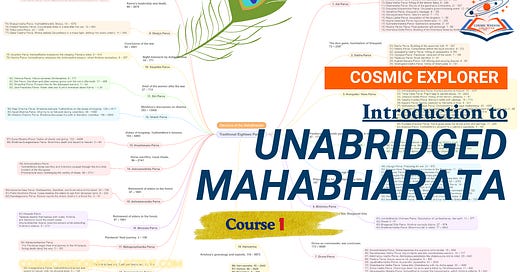Welcome, everyone! Today, we embark on a journey into the heart of the Mahabharata, one of the greatest epics of all time. This isn't just a story about a war; it's an ocean of knowledge, philosophy, and profound insights into the complexities of human nature. We're diving into the unabridged Mahabharata—the original, nuanced version that offers a richer narrative than the simplified retellings you may know.
Why the Unabridged Mahabharata Matters
The unabridged Mahabharata is often described as an encyclopedia of life, capturing every human experience. It examines the four primary goals of existence:
Dharma (righteousness)
Artha (wealth)
Kama (desire)
Moksha (liberation)
Unlike the Ramayana, which is rooted in idealism, the Mahabharata deals with realism. It explores complex situations where the boundaries between right and wrong blur. For example, should you adhere to truth if it leads to harm? This focus on dilemmas and choices makes the Mahabharata deeply relatable, even today.
Did you know? The unabridged Mahabharata doesn't reduce characters to heroes or villains but delves deep into moral dilemmas, human emotions, and philosophical debates that still resonate.
Origins and Composition: A Living Document
The Mahabharata belongs to the smriti tradition, meaning it was passed down orally before being written. Traditionally attributed to Krishna Dvaipayana Vedavyasa, a sage known for his wisdom and for organizing the Vedas, the epic wasn't composed at one time. It evolved over centuries—between 800 BCE and 400 CE—as different authors added layers to its narrative.
Originally, it was a shorter text called Jaya, containing 8,800 shlokas. This evolved into Bharata with 24,000 shlokas, and finally, the Mahabharata we know today, with around 80,000 shlokas.
Interesting Fact: The critical edition of the Mahabharata, compiled between 1919 and 1966, highlights these layers, striving for authenticity by eliminating later additions.
Beyond Myths: Embracing Complexity
Popular myths, like Vyasa dictating the epic to Ganesha, are not part of the unabridged version but reflect how cultural storytelling has enriched its legacy over time. The unabridged Mahabharata includes:
Pro-Kaurava stances, showing that even they had justifiable grievances.
Critical perspectives on Krishna, presenting him as a strategist whose actions were not universally admired.
Characters are multi-dimensional:
Duryodhana, often portrayed as a villain, is also called Suyodhana, meaning 'noble warrior.'
The Bhagavad Gita, often viewed as a standalone spiritual guide, is deeply contextual within Arjuna’s moral crisis on the battlefield.
The Structure: An Intricate Narrative
The Mahabharata's vast narrative is organized into eighteen major books (parvas), each with distinct themes and episodes. This structure allows it to seamlessly blend divine myths, cosmic themes, and real-world connections.
Divine Stories: Woven throughout, with gods intervening and cosmic events shaping the narrative.
Cosmic Themes: Explored in depth, especially in discussions about time cycles and universal truths.
Geographical Content: Rich details of real-world locations like Kurukshetra and Hastinapura ground the epic in reality.
Timeless Themes and Core Concepts
Dharma (Righteousness)
The Mahabharata presents dharma not as a fixed concept but as a complex, evolving idea. Characters face conflicting duties, illustrating how dharma depends on context.
Yudhishthira's adherence to truth leads to his downfall in the dice game.
Arjuna's dilemma about fighting his own kin is central to the Bhagavad Gita.
Karma (Action and Consequences)
Every action has repercussions. The epic emphasizes the inevitability of consequences.
Duryodhana's greed leads to his downfall.
Karna's loyalty aligns him with unrighteousness, resulting in a tragic end.
Complexity of Human Nature
Characters are neither wholly good nor evil.
Bhishma upholds his vow but fails to prevent injustice.
Karna is noble yet flawed, torn between loyalty and righteousness.
Historical and Cultural Significance
The Mahabharata reflects ancient Indian society, politics, and ethics.
Social Hierarchy: Challenges rigid norms through characters like Vidura and Ekalavya.
Political Insights: Explores governance, leadership, and the consequences of unchecked ambition.
Ethical Dilemmas: Presents conflicts between personal duty and the greater good.
Real-World Connections: Archaeological findings align with descriptions in the epic, grounding its stories in historical reality.
Relevance Today: A Mirror to Modern Life
The Mahabharata's themes are universal, addressing human conflicts and dilemmas that are still relevant.
Personal Conflicts: Balancing duty and morality, as seen in Arjuna's crisis, mirrors modern ethical dilemmas.
Leadership Lessons: The dice game illustrates the perils of poor governance.
Philosophical Insights: The Bhagavad Gita's teachings on selfless action and duty continue to inspire.
Conclusion: Embracing the Epic's Depth
Think of the Mahabharata not as a simple story but as a living document of human experience. Its unabridged version offers invaluable insights into ethical dilemmas, human nature, and the consequences of choice.
Ready to dive deeper? In the next lesson, we'll explore the Mahabharata's fascinating structure and themes, uncovering how it integrates philosophy, history, and storytelling. Join us as we continue this enlightening journey!













Share this post